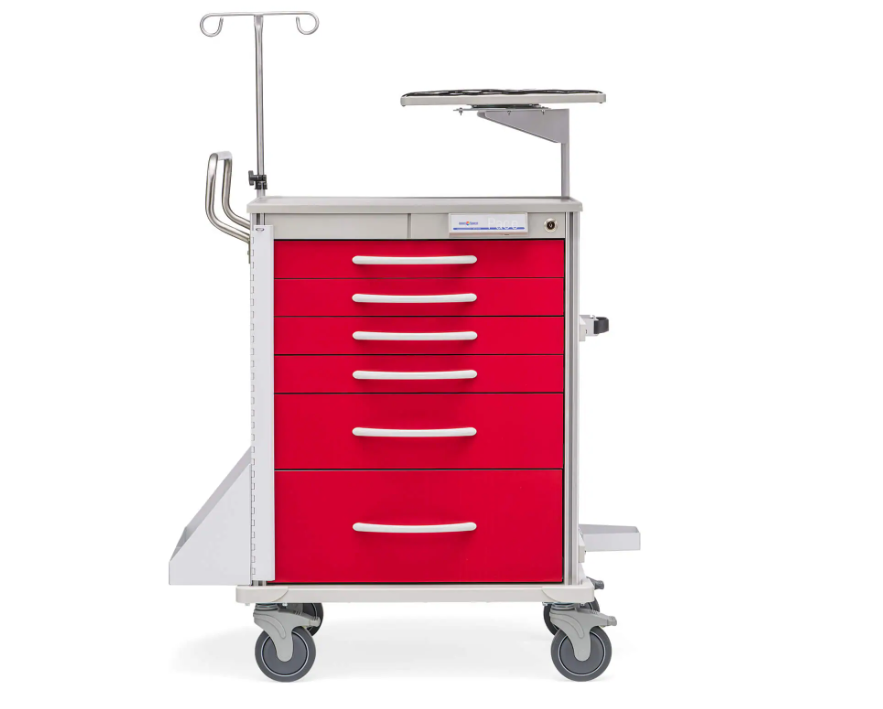
Many people think of hospital code carts, or crash carts, as mobile emergency aid carts for heart attack victims. But code carts can offer life-saving equipment for various health crises, such as allergic reactions, strokes, drug overdoses, and cardiac events.
Any medical facility that serves patients can encounter life-threatening medical emergencies. In addition to calling 911, healthcare staff should be able to respond with the highest level of emergency care that they are qualified to provide until EMS services arrive and take over. A well-maintained code cart can help save a life by shaving minutes off your staff’s response time.
What Is a Code Cart?
According to the ACLS Training Center, a code cart is a “ self-contained, mobile unit that contains virtually all of the materials, drugs, and devices necessary to perform a code.”
Code carts were first used in the 1960s when Anita Dorr, an emergency room nurse, became frustrated with how long it took to find all the supplies needed to respond to medical emergencies. In 1968 Dorr built a “crisis cart” for use in the emergency room. This emergency room crash cart included equipment she and her colleagues deemed necessary to respond to patients exhibiting a medical crisis.
Dorr’s “crisis cart” may not have been the first crash cart. Dr. Joel J. Nobel received the first patent for a crash cart dubbed “Max”, which he designed during his surgical residency in 1965. And in 1963, as described in a review article in the World Journal of Emergency Medicine, a “resuscitation trolley” was in use in an emergency department in England.
What’s In a Code Cart?
The ACLS Training Center publishes a list of supplies that any code cart should have:
- Medications
- IV solutions
- IV supplies
- Intubation materials
- Procedure supplies
- Defibrillator
- List of code cart supplies
No agency regulates code cart contents. However, the ACLS Training Center reports that code carts must have the medical equipment necessary to manage any life-threatening medical emergency that may occur in that facility, based on the patient population. A pediatric code cart setup will look different from one in a cardiac stress test center.
The Joint Commission, a global driver of quality improvement and patient safety in health care, recommends that code cart drawers or trays are labeled, and contents are clearly marked and easily accessible. Standardizing the contents of your code carts and only including what is needed can help the staff become familiar with the contents and decrease their emergency response time.
Why Does My Facility or Specialty Practice Need a Code Cart?
State regulatory agencies set policies on which facilities are required to have code carts available in the event of a patient, staff, or visitor emergency. However, many other facilities and offices that provide patient care should consider stocking code carts, such as:
- Nursing homes
- Radiology centers
- Substance abuse treatment centers
- Urgent care centers
- Allergist offices
- Cardiac diagnostic testing centers
- Surgical centers
- Specialist and dental offices that provide sedation
When a patient has chest pain, is found unresponsive, or has an anaphylactic reaction to sedation, the emergency response should be rapid and organized.
As Dorr found, back in the 1960s, valuable time was wasted when emergency medical supplies were not easily accessible. The ability to quickly access basic life-saving medical supplies, such as a defibrillator, medications, and respiratory support equipment, can help staff meet the goal of providing fast, appropriate emergency care.
The responsibility of having a code cart on-site includes the development of policies and procedures. A code cart also offers the opportunity to provide valuable training to your staff, ensuring that any patient with a life-threatening medical condition receives prompt and appropriate care.
Specialty carts are also practical for various procedures, such as an open suture cart or an isolation cart. Choose a cart that can be configured for your facility’s particular needs.
The Joint Commission published an informative document to help you ensure your code cart is prepared for any medical emergency. This document highlights common issues and corresponding solutions, such as employing routine code cart checks to identify expired medications and providing ongoing staff education to ensure patient emergencies are handled appropriately.
Consider adding a code cart to your facility’s emergency response plan.
The American Heart Association reports a patient’s chance of survival doubles or triples when cardiopulmonary resuscitation is performed immediately after cardiac arrest. Healthcare providers can go one step further to ensure the best clinical outcomes for their patients by equipping their facility or unit with a code cart.

Cindy Blye
Content WriterCindy Blye, BSN, RN, CCM is a Registered Nurse and Certified Case Manager. She is an Alumni of West Virginia University School of Nursing (BSN), and a member of the Association of Health Care Journalists and The Authors Guild.
